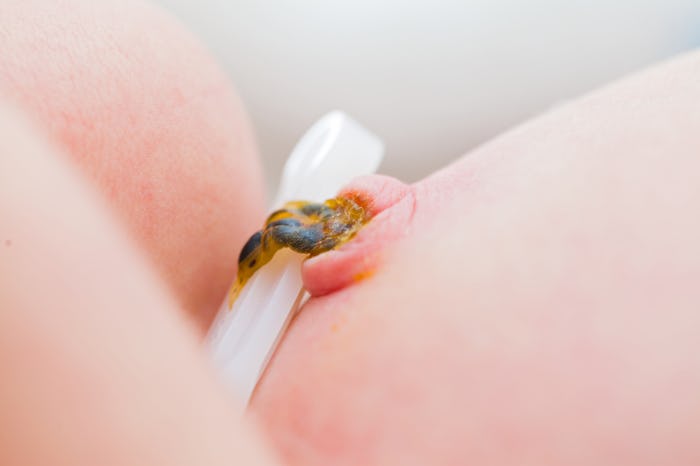Life

Here's When You Can Expect Your Baby's Umbilical Cord Stump To Fall Off
Caring for a newborn can be tricky, whether you’re an experienced mom or a first timer. You have to learn your baby’s cues and cries, figure out their sleep schedule (because they dictate it), and learn how to swaddle and feed them. But when you are bathing them for the first time, you might be concerned with touching or agitating the leftover umbilical cord on their belly button. Eventually it will be gone, but exactly when does the umbilical cord stump fall off?
According to the American Pregnancy Association, the umbilical cord is what supplies nutrients from your blood to the baby via the placenta. When the baby is born, the umbilical cord is cut, leaving a tiny little stump on their belly button. The cord then dries out and eventually falls out, leaving behind a cute little belly button. Romper reached out to pediatrician Gina Posner, M.D. of Orange Coast Medical Center in Fountain Valley, California, who says that most umbilical cords will fall off about five to seven days after the baby’s birth, but it is still considered normal range if it falls off within three weeks of age. After your baby hits the three week mark, if the umbilical cord is still attached, Posner says it is considered abnormal separation time.
There is a routine to be mindful of when it comes to cleaning and caring for your baby’s umbilical cord stump, too. Posner says that the most important thing for parents to do is not get it wet. She suggests that you should not bathe the baby until the stump falls off, although you can sponge bath the baby while keeping the belly button area dry. You should also mindful of the area when diapering your baby. “The diaper should be folded below the umbilical cord at all times.” adds Posner.
Pediatrician Eric Morley, M.D. of MemorialCare Saddleback Medical Center in Laguna Hills, California, tells Romper that to keep the area clean, you can wipe around the stump with a damp cloth if needed, but just be mindful that it is never submerged in water until it falls off. He also says that parents should keep an eye out for infection of the umbilicus (the umbilical cord stump), which can be very serious. “Signs of infection include redness and firmness of the skin around the umbilicus,” says Morley, “along with possible foul-smelling discharge.”
If you are thinking of using products to dry out the cord stump faster, you may want to reconsider. Catherine Gritchen, M.D., a pediatrician with Miller Children’s & Women’s Hospital in Long Beach, California, tells Romper that when you keep the cord stump clean and dry, it allows natural beneficial bacteria to help dry and separate the cord. But when you use any type of antibacterial application, such as alcohol or triple dye, Gritchen says you may actually delay the cord separation because you are killing off that beneficial bacteria that helps it fall off naturally. “Also, it can select for opportunistic 'bad' bacteria,” adds Gritchen, “actually increasing chance of infection.”
Gritchen says that back in the day, it was common practice for parents to use topical applications to dry out the cord stump. “Many grandparents or older parents will remember the application of the 'blue dye' to the cord after birth, or recommendations to use alcohol daily,” says Gritchen, “but this is no longer considered best practice for our community, and for most of the United States.”
So as long as you keep the umbilical cord stump dry and clean, it should fall off within the first week or two after your baby’s birth, but can also take up to three weeks to fall off in some cases. Just remember to follow the proper care routine, and you’ll be seeing your baby’s adorable little belly button in no time.
Check out Romper's new video series, Romper's Doula Diaries:
Watch full episodes of Romper's Doula Diaries on Facebook Watch.